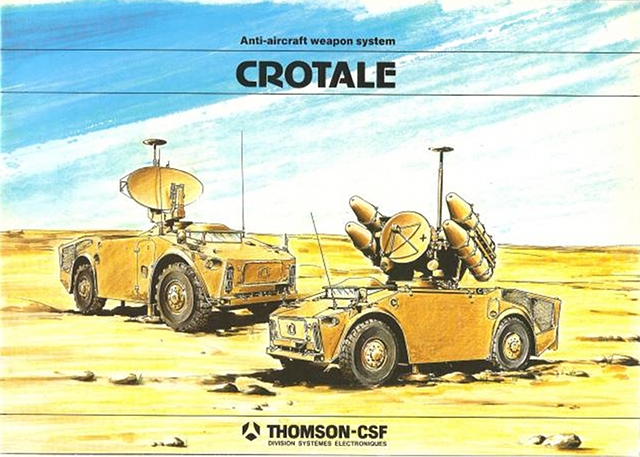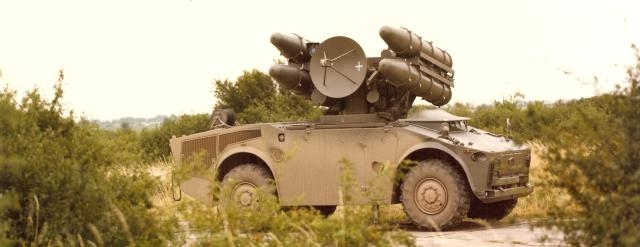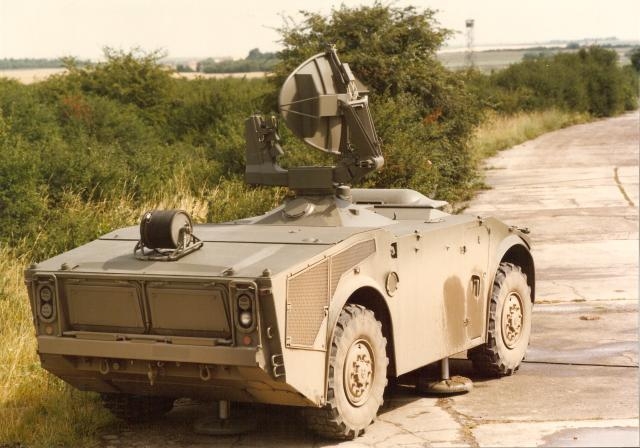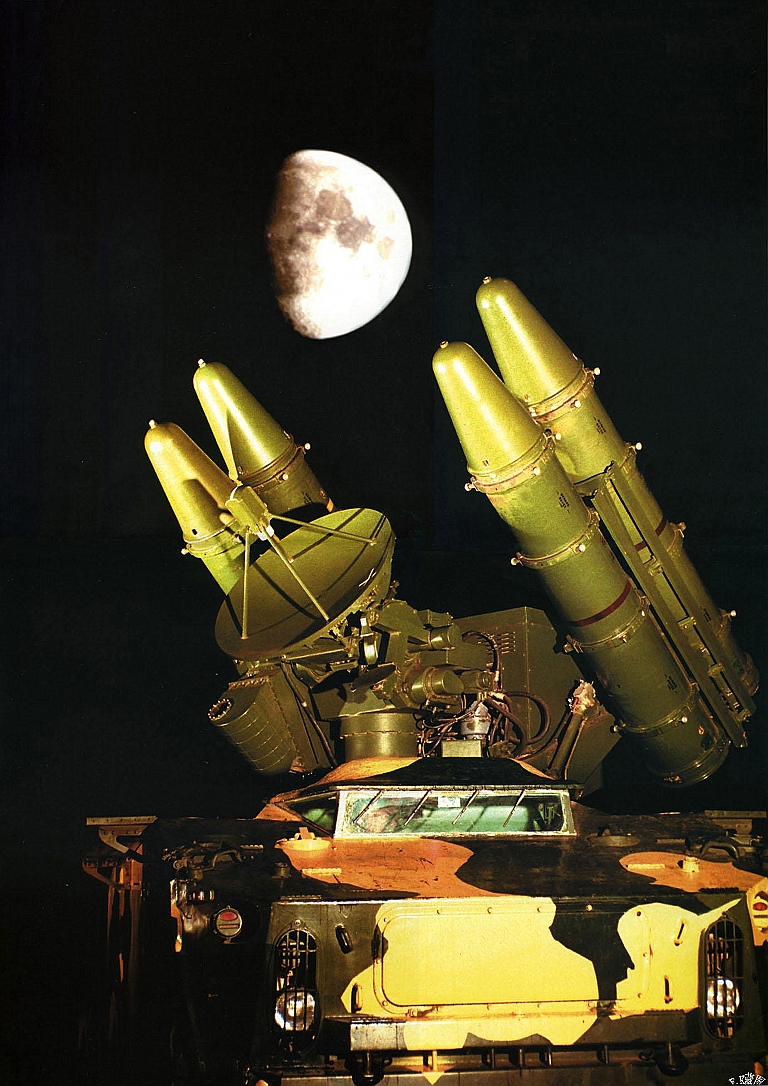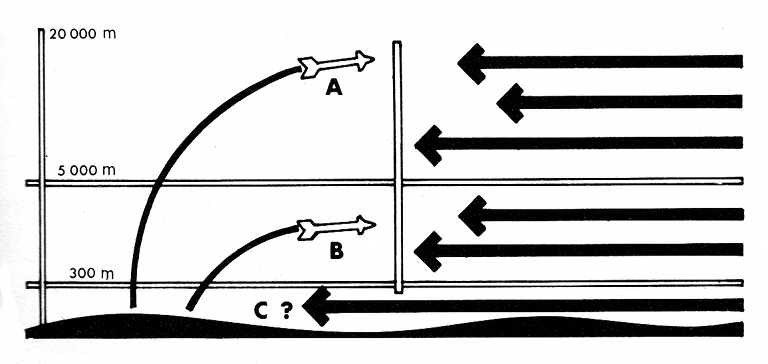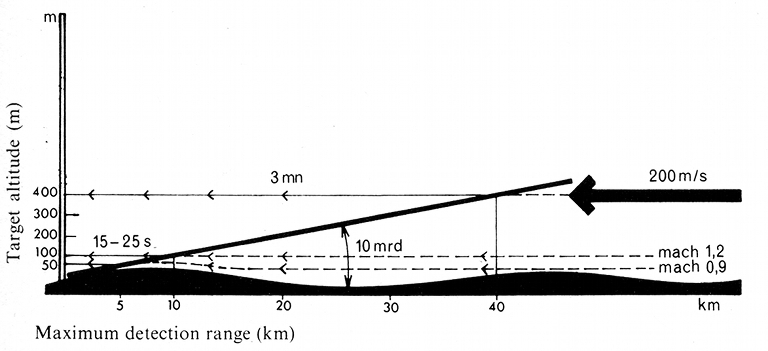|
||||||||||||||||||||||
![Home - Air Power Australia Website [Click for more ...]](APA/APA-Title-Main.png) |
||||||||||||||||||||||
![Sukhoi PAK-FA and Flanker Index Page [Click for more ...]](APA/flanker.png) |
![F-35 Joint Strike Fighter Index Page [Click for more ...]](APA/jsf.png) |
![Weapons Technology Index Page [Click for more ...]](APA/weps.png) |
![News and Media Related Material Index Page [Click for more ...]](APA/media.png) |
|||||||||||||||||||
![Surface to Air Missile Systems / Integrated Air Defence Systems Index Page [Click for more ...]](APA/sams-iads.png) |
![Ballistic Missiles and Missile Defence Page [Click for more ...]](APA/msls-bmd.png) |
![Air Power and National Military Strategy Index Page [Click for more ...]](APA/strategy.png) |
![Military Aviation Historical Topics Index Page [Click for more ...]](APA/history.png)
|
![Intelligence, Surveillance and Reconnaissance and Network Centric Warfare Index Page [Click for more ...]](APA/isr-ncw.png) |
![Information Warfare / Operations and Electronic Warfare Index Page [Click for more ...]](APA/iw.png) |
![Systems and Basic Technology Index Page [Click for more ...]](APA/technology.png) |
![Related Links Index Page [Click for more ...]](APA/links.png) |
|||||||||||||||
![Homepage of Australia's First Online Journal Covering Air Power Issues (ISSN 1832-2433) [Click for more ...]](APA/apa-analyses.png) |
||||||||||||||||||||||
| Last Updated: Mon Jan 27 11:18:09 UTC 2014 | ||||||||||||||||||||||
|
||||||||||||||||||||||
|
CPMIEC HQ-7/FM-80 / CSA-4 Sino-Crotale
CPMIEC HQ-7/FM-90 / CSA-5 Sino-Crotale Self Propelled Air Defence Systems Technical Report APA-TR-2010-0901 |
||||||||||||||||||||||||||||||||||||||||||||||||||||||||||||||||||||||||||||
| Carlo
Kopp,
BE(hons),
MSc,
PhD, AFAIAA,
SMIEEE,
PEng Martin Andrew, BA(hons), MA, PhD, RAAF(Retd) Imagery © 2010 Air Power Australia September, 2010 Updated January, 2011 Updated April, 2012 Text, Line Art © 2009 - 2012 Carlo Kopp  |
||||||||||||||||||||||||||||||||||||||||||||||||||||||||||||||||||||||||||||
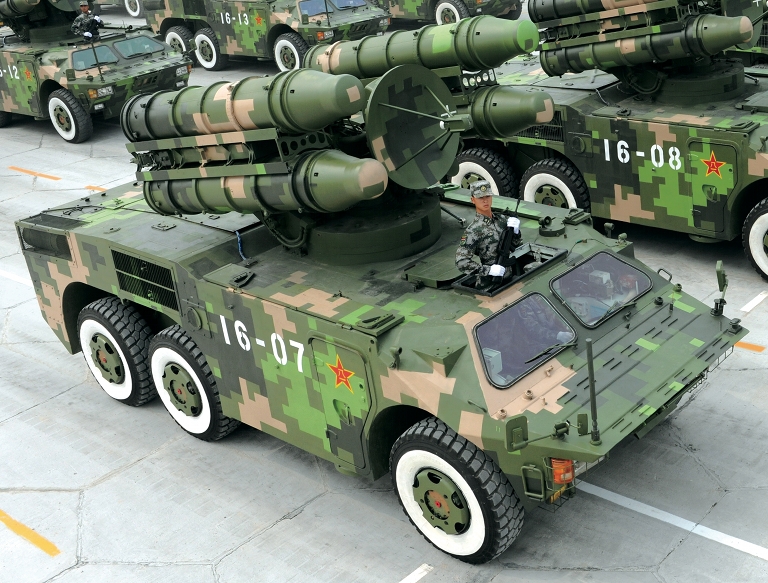 China
continues
to
manufacture
and
export
the
cloned
Crotale
SAM.
The
latest HQ-7B/FM-90
Crotale
variant is carried on
a new
Chinese designed 6 x 6 AFV chassis, replacing the cloned French Thomson-Hotchkiss P4R
chassis. Additional image [1]
(via Chinese internet).
|
||||||||||||||||||||||||||||||||||||||||||||||||||||||||||||||||||||||||||||
| |
||||||||||||||||||||||||||||||||||||||||||||||||||||||||||||||||||||||||||||
IntroductionThe
HQ-7 is a Chinese clone of the French Thales/Thomson CSF Crotale SAM.
During
the 1970s the French supplied samples of the Crotale
which
was promptly reverse engineered. The cloned Crotale has been built in
two
configurations, a high mobility variant for PLA Army units on a 4 x 4
cloned French Thomson-Hotchkiss P4R armoured
vehicle, and a less mobile PLA-AF air field defence system, using
either a
trailer or a truck platform. Since then, derivative variants have
emerged in the FM-90 series, in addition to the shipboard variants. The
Thomson-Hotchkiss P4R vehicle uses either a diesel or
gasoline engine driving an alternator which powers electrical motors
driving the wheels. Chinese sources sometimes label the P4R as a B-20.
A naval variant of the Crotale as also been developed. |
||||||||||||||||||||||||||||||||||||||||||||||||||||||||||||||||||||||||||||
|
China was supplied by France with a small
number of Crotale and Sea
Crotale systems during the late 1970s, for evaluation purposes. The
post Tiananmen embargo prevented import of production quantities.
Chinese sources claim that the 2nd Academy reverse
engineered the
missiles, the 23rd Institute the radar systems, and the 206th
Institute
the Hotchkiss P4R vehicle. The reverse engineered Crotale and Sea
Crotale entered production about a decade later, designated the HQ-7
and HHQ-7 respectively. Export variants have been designated FM-80, and
FM-90 in the evolved variant.
In terms of capabilities and performance the HQ/HHQ-7/FM-80/90 closely compare to the Soviet/Russian built Almaz-Antey/Kupol 9K331M/M1 Tor M/M1 SA-15B/C Gauntlet and early configurations of the KBP 2K22M1/2S6M1 Tunguska-M1/ SA-19 Grison SPAAGM missile system. The key difference is that both Soviet/Russian systems integrate the acquisition radar on the TELAR, and were designed like the 9K33 Osa / SA-8 Gecko before them, to “shoot and scoot”, providing high mobility point defence capability for land force manoeuvre elements. The baseline Crotale, which is the basis of the HQ-9, was built for rapid intra- and inter-theatre redeployment, but limited “shoot and scoot” capability. The original design aim of the Crotale was to engage supersonic low flying fighters, to provide a rapid reaction terminal point defence for airfields, and other high value static or redeployable targets. PLA Crotale units appear to remain dedicated to this role. The kinematic performance of the Crotale missile and angular field of regard of the engagement radar are both compatible with the “Counter-PGM” role, which has now become the primary role of the Russian 96K6E Pantsir S1E / SA-22 and 9K331M2E Tor M2E / SA-15D. While the new acquisition radar for the HQ-7B / FM-90 has the technological potential for use in this role - it employs the same antenna technology as the 9K331M2E Tor M2E / SA-15D - there is no evidence to date that the PLA intends to reorient the operational use of the HQ-7B to “Counter-PGM” role. Equally so, there is no evidence of any indigenous PLA effort to develop a unique replacement for the HQ-7/HHQ-7 series. Given the past propensity of the PLA to extract every possible use out of a mature design, and the inherent growth potential of the Crotale family as demonstrated by the evolution of EU Crotale variants, the most likely outcome is that the HQ-7/HHQ-7 will continue to evolve new variants for the forseeable future. |
||||||||||||||||||||||||||||||||||||||||||||||||||||||||||||||||||||||||||||
HQ-7/HHQ-7
/
Sino-Crotale Technical Analysis
|
||||||||||||||||||||||||||||||||||||||||||||||||||||||||||||||||||||||||||||
| Design principles A multi-capability solution to the low altitude problem should therefore provide the following: 1. Radar detection in all weathers of a 1 m2 fluctuating target flying at speeds up to Mach 1.2, amongst ground clutter and fixed echoes of 105 m2 equivalent area (corresponding to a collection of large buildings seen against a rock face 1,500 metres taller). 2.Tracking of the target accurately in this environment, even if it flies at ground level, hugs the side of a hill or valley, or passes through a nodal point close by. Guidance of the missile accurately under whatever conditions the target imposes. 3.Fast reaction, so that the following operations can take place whilst the aircraft in question (flying at Mach 1.2) travels no more than 4 km, allowing an intervention time of just under 10 seconds:
6. Maximum reliability in spite of enemy electronic countermeasures. Detection of faults the moment they occur and not when the approach of an enemy aircraft sets off the full operating sequence. 7. Simplified training of operating and maintenance crews. |
||
| The following are the
solutions which have been adopted to fulfil the
stated requirements: 1.A fully coherent [Mirador IV] pulse Doppler surveillance radar. This will detect aircraft of an area equivalent to a 1 m2 fluctuating target flying at radial speeds of 35 to 440 m/s (156 to 890 mph) at altitudes from 0 to 3,000 m (0 to 10,000 ft) and ranges up to 18.5 km (11.5 miles). At maximum range the probability of detection is 90% with each antenna revolution. The chances of a false alarm are low and radar visibility through the fixed echoes is so good that even when Crotale was tested in the most difficult conditions, no ground shadow whatever appeared on the screen. A computer logic circuit correlates the data gathered on each antenna revolution, rapidly extracting all but the useful information and allowing automatic tracking of any aircraft within detection range. So as not to lose the benefits of the fast reaction time, information is renewed at the very high rate of one antenna revolution per second. Using a pulse Doppler radar, this antenna revolution speed is incompatible with precise target definition and suppression of ambiguities and 'blind speeds' within the range limits imposed by the terrain, unless the S-band is used for the surveillance role. The radar coverage is so designed that it immediately provides not only the bearing of the target. but also a first indication of its range and elevation (high, medium or low). 2.Tracking of the target is carried out by a Ku band [Castor 2] monopulse radar, the narrow beam and short pulse of which give very high definition; the use of multiple frequencies gives good protection against jamming as well as very smooth tracking. The tracking radar antenna has been separated from the co-axially mounted missile launchers, in order to reduce its inertia to a minimum. Missile guidance is accurate to within 0.1 milliradians, this unequalled performance being the result of using the beam-riding guidance technique in direct combination with the target tracking technique described above. This process eliminates the mechanical and electronic errors common to systems with separate target tracking and missile guidance equipment. 3. The very fast reaction time required of the system necessitates total automation. Crotale is the first example of a weapon system to be so designed. A computer mounted in the surveillance/target designation vehicle determines whether the target is approaching or receding and its nature (one or several aircraft); it processes the data provided by radar, initiates tracking of each aircraft, and classifies it in terms of immediacy of the threat in relation to other targets already being tracked. After identification of the aircraft as hostile, the computer communicates with its counterparts in the firing unit vehicles, before assigning the target to whichever of the latter is best placed to deal with it. This causes all the uncommitted tracking radar/missile launcher mountings to turn towards the target. The designated fire unit then receives an accurate bearing on the target, together with its approximate elevation and height. The fire unit computer then guides the tracking radar within these limits, by continually updating target elevation and height data (Fig. 3), until the automatic tracking mode locks on. During this period of search, the fire unit computer remains under the overall control of the computer in the surveillance/target designation vehicle. It calculates the interception possibilities and decides when target engagement becomes possible. Once the order to fire is given, several irreversible missile launching procedures take place: internal power is switched on, the autopilot is activated, the missile container is opened, and the missile is fired. At any time between tracking lock-on and interception of the aircraft, a 'friendly' IFF response, however belated, will automatically interrupt the intercept sequence; if this occurs during missile flight, the latter will destroy itself. On the standard version of the Crotale system, the intervention of human operators has been kept to two levels:
The attachment of several fire units to the same surveillance unit allows the most flexible and economic defense of various types of point targets. One surveillance unit will therefore be under-utilised in many cases if it is linked with only one firing unit. But more important still, if the fire of the various units co-operating to protect the same target is not co-ordinated, then there is nothing to prevent those fire units whose operating envelopes overlap engaging the most urgent target simultaneously, leaving the field wide open for following aircraft. By ensuring the co-ordination of several firing units against a large-scale attack therefore, the Crotale organisation optimizes their performance. 4.The firepower of Crotale results from the combined effect of several devices which have been incorporated in the system. An advanced operational research study showed that, faced with the threat posed in the next decade and taking account of the restricted range of fire compatible with terrain limitations, the beamriding guidance technique with continuous deviation correction offers a cost-effectiveness ratio superior to any other. Designed and produced by Engins Matra with the assistance of several divisions in the Thomson Brandt group for in particular, the propulsion unit,, the warhead and the transponder, the Crotale missile is gathered by the radar in under 500 metres. Its single-stage motor propels it to Mach 2.3 in 2.3 seconds. and at the limit of its range its speed is still supersonic. The missile is roll-stabilized in order to allow a high degree of guidance precision and to provide the ability to absorb the high load factors imposed by crossing targets. Canard-type surfaces provide the required manoeuvrability with a minimum of drag, and at the limit of combat range, the missile still has a manoeuvrability of 7 g which allows it to cope with fluctuations and evasive manoeuvres of the target. The 15 kg warhead was specially designed for high efficiency: its detonation produces a burst of fragments moving at over 2,000 m/sec localised in space and time, the fragments retaining the same lethality to a distance of 8 metres. The warhead is detonated by an infra-red proximity fuze in the standard version (an electromagnetic fuze is optional) at a point determined by the ground-based computer as a function of the relative positions of the missile and its target. The flexibility of the digital computer allows full simulation of the firing and intercept sequence before it takes place. This permits, for example, the avoidance of a situation in which a missile could be fired at an aircraft which would be masked by terrain at the theoretical point of interception: a firing lock avoids waste of this missile. In the same way, if it appears that an airborne target will present itself in conditions which would make interception difficult (very high speed, very brief appearance within the limits of action of the missile) so degrading the hit probability, the computer will give authority to launch a salvo of two missiles the moment the operator presses the firing button. All these provisions have allowed verification during the firing trials that the 90% destruction probability indicated by the design calculations can, in fact, be achieved in reality. 5.To conform to the requirement to support mobile combat forces, it was necessary that the surveillance radar be capable of giving the alarm whilst on the move, so as not to lose the advantage of the very short reaction time by a long detection period. Without this capability, it would be necessary to resort to the classic “leapfrogging” technique with the slowness of movement and the doubling of surveillance equipment which it involves. The stable oscillator of a pulse Doppler radar is sensitive, in certain frequency ranges, to the mechanical vibrations of vehicles. These generate false alarms which the computer confuses with the actual signal of an airborne target. To eliminate these vibrations, mechanical transmission has been dispensed with and a very flexible suspension adopted for the thermal [internal combustion engine in P4R] motor. The power supplied by this motor, converted into electrical energy, is fed via cables to electric motors on each wheel. The missile launch vehicle uses the same system. The first military application of a principle already proven commercially, combined with a very elaborate hydropneumatic suspension system, ensures a smooth ride for the Crotale vehicles on varied terrain, and a high initial starting torque [characteristic of DC electric motors], well above the usual norms for a four wheeled air transportable vehicle of 13 tonnes powered by the 230 SHP motor. |
||
The HQ-7/FM-80 ACU antenna is of a similar configuration to the Mirador IV, with a feed boom and rear V-shaped structural frame which appear identical. The sculpted Mirador IV reflector is replaced by a truncated concave mesh and frame reflector, which permits a HQ-7 ACU to be easily recognised when compared to the Thomson-CSF original product.
The digital data processing system communicates with the Fire Units through a datalink interface, which employs either cable or radio link channels. The cable allows communication between the ACU and a fire unit up to distances of 400 metres. The alternate VHF-band radio datalink permits communication over distances of 50 to 5,000 metres.
The Fire Unit Thomson-CSF Castor 2J/C pulse Doppler engagement radar employs a circular parabolic reflector with splayed monopulse feeds on a characteristic four spoked strut frame, which appears identical on both HQ-7 Type 345 systems and French built Crotales. The radar operates in the Ku band producing a 1.1° circular pencil beam for target tracking. Three channels are used to permit tracking of a single target and one or two outbound missile round Ku-band transponders, the arrangement intended to minimise the relative angle errors between target and missile tracks. An X-band missile uplink is employed. Frequency agility is employed to minimise susceptibility to jamming. For a more detailed discussion refer HQ-7/FM-80FS/FM-90FS/Type 345 Crotale Engagement Radar.
An infrared tracker with a ±5° FOV is employed to ensure that the antenna boresight is aligned with the missile flightpath vector immediately after launch, before the missile is captured by the guidance command link 500 metres after launch.
The Fire Unit digital mission computer is employed to calculate the parallax offset relative to the ACU, acquisition and tracking algorithms, speculative intercept parameters against possible targets, command uplink instructions for missile capture and command link guidance to intercept, fusing control calculations, and missile self destruct commands.
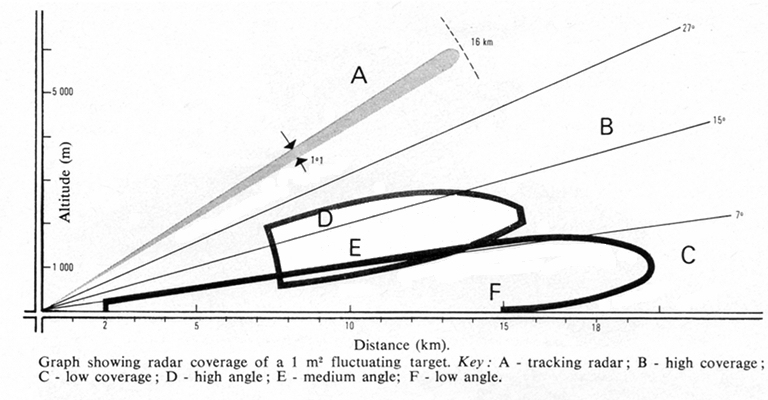
Conceptually the HQ-7/Crotale radar suite most closely resembles its Soviet/Russian analogues, the Land Roll system in the 9K33 Osa / Romb / SA-8 Gecko, and the later 9K331 Tor / Tor M/M1 / SA-15 Gauntlet. The French design is cleaner and more compact, and shares the antenna across multiple functions, whereas the Soviet/Russian designs employ additional function specific antennas.
Figure 3, reproduced from le Sueur's paper, shows the transfer of the target track from the ACU to the Fire Unit. The Mirador IV localises the target into an angular box cited at 4 milliradians, which falls well inside the 20 milliradian mainlobe angular coverage of the engagement radar. This permits the Castor 2 to acquire and lock very rapidly, as the acquisition and lock process primarily involves driving the antenna boresight to null the initial angular error, and establishing range and velocity tracks. There is no need for the Castor to perform a search to place the target into the mainlobe.
Unvalidated Chinese Internet claims are that the FM-90 is fully digital, and the engagement radar operates in two bands to improve ECCM capabilities - the Russians employed a dual band engagement radar in this class in developmental variants of the 96K6 Pantsir S - and that the FM-90 is intended to engage cruise missiles, ASMs, anti-radiation missiles and aircraft.
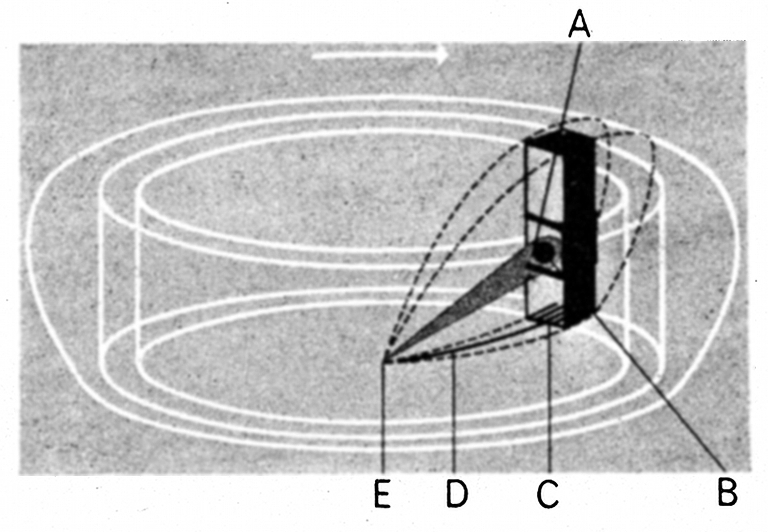
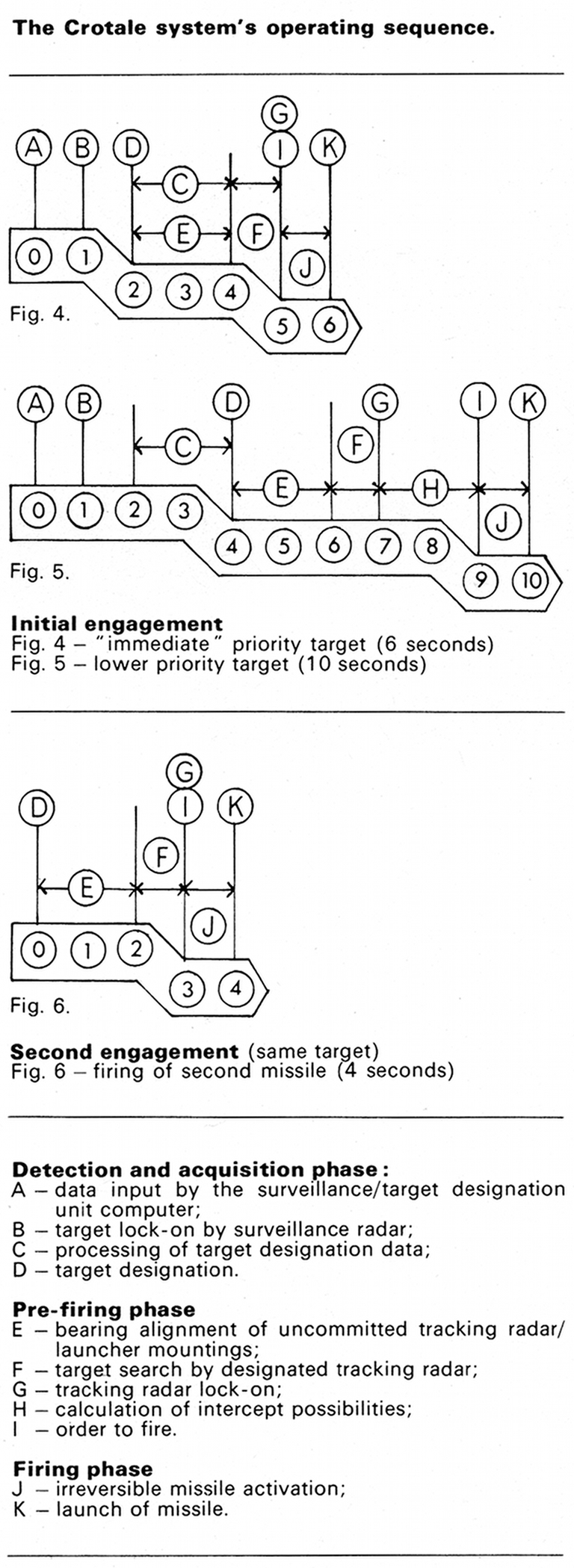
Figure 4, 5, 6 Crotale engagement sequences[2].
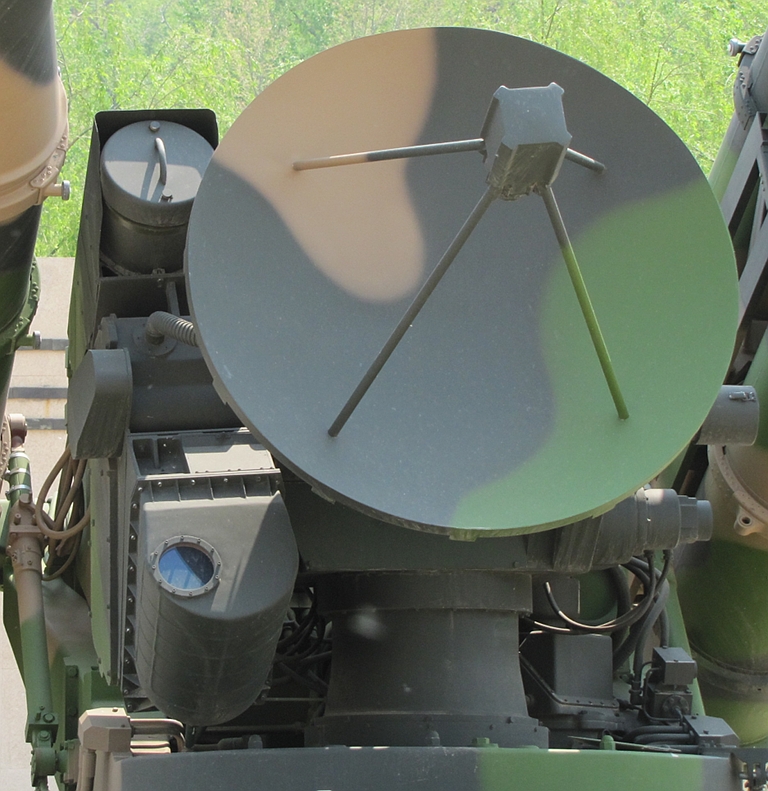
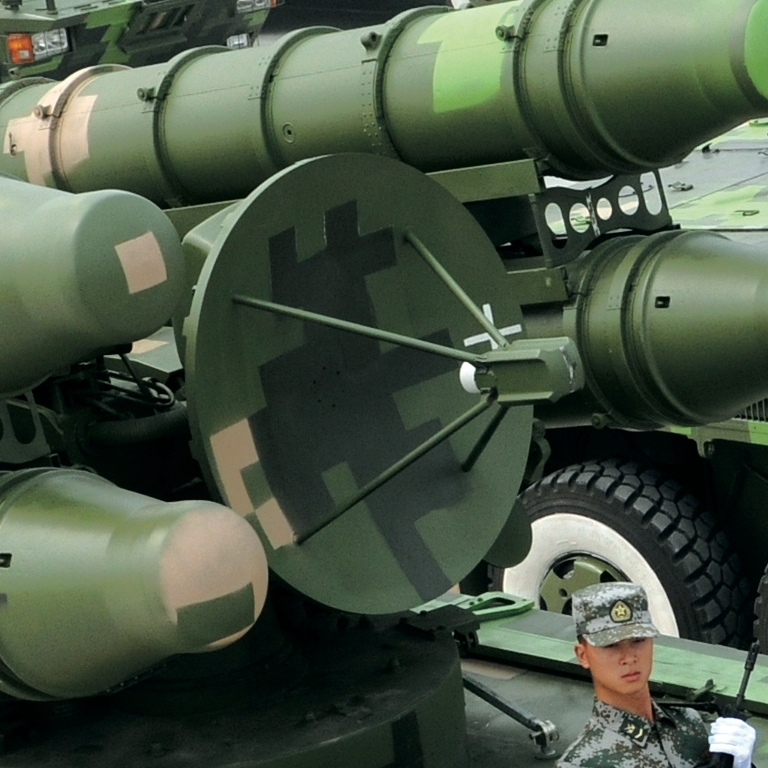
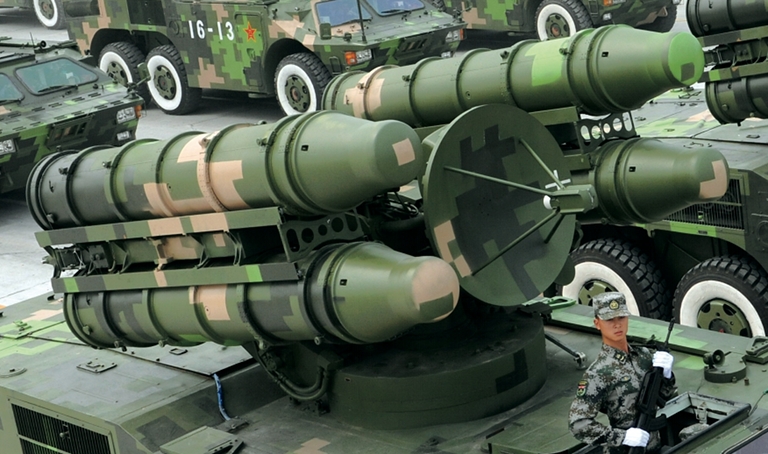
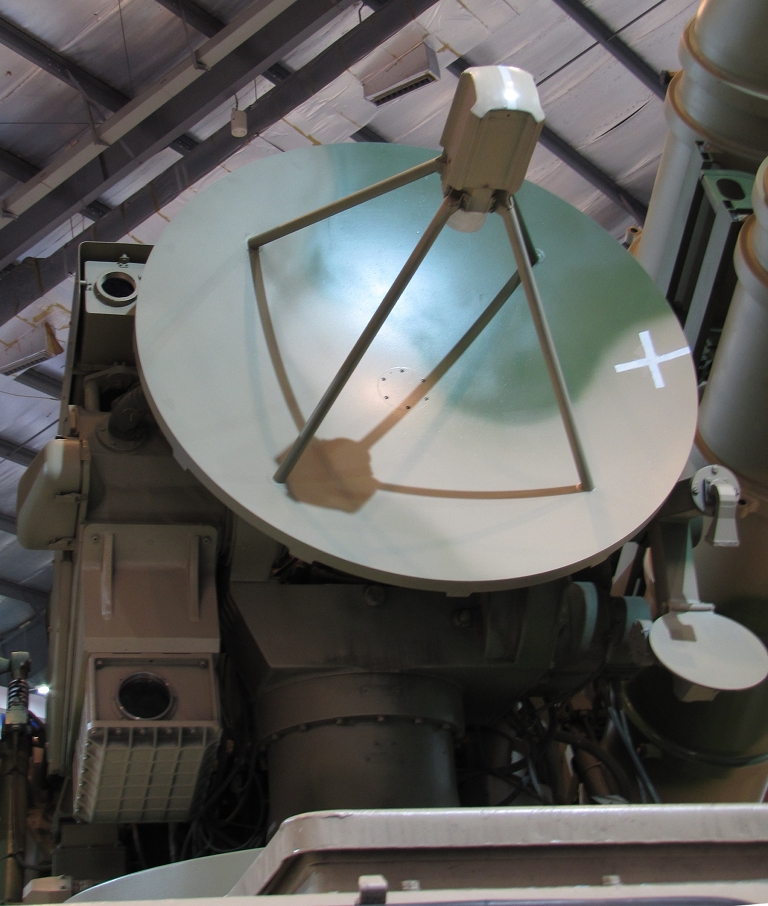
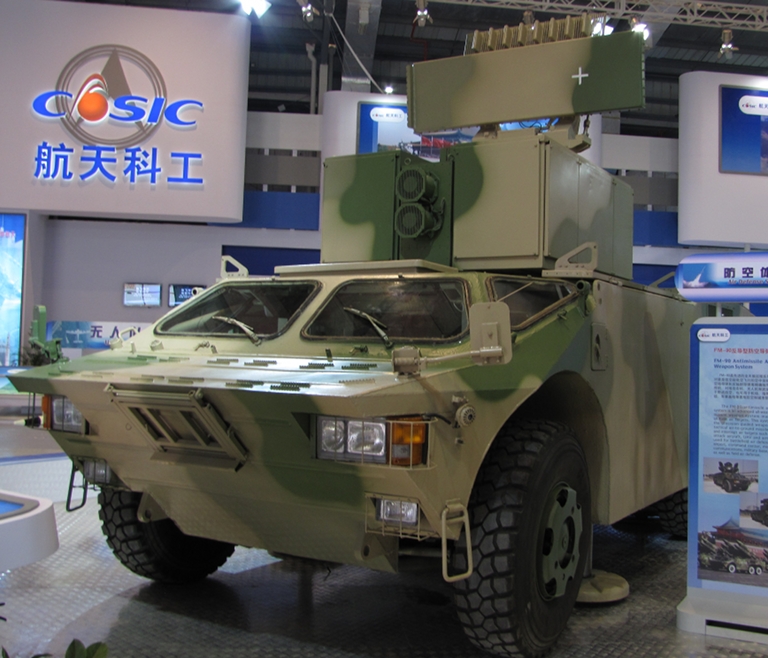
FM-90 ACU (Zhenguan Studio, © 2010 Air Power Australia).
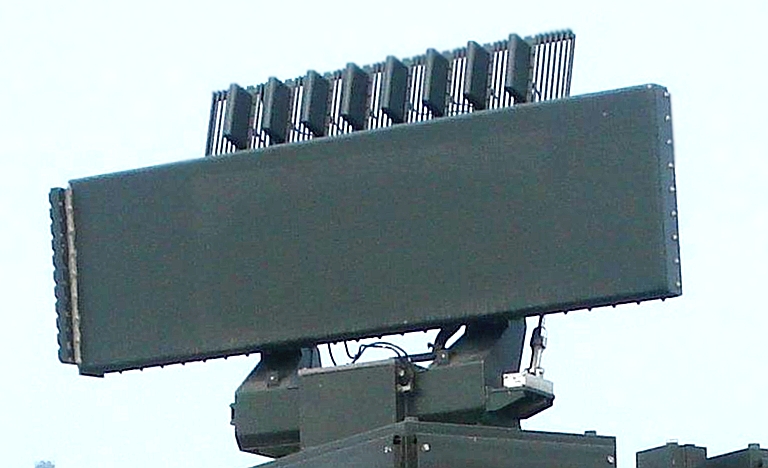
Detail of FM-90 ACU acquisition radar antenna. This is a mechanically steered rotating 3D planar array design with frequency scanning of eleven element rows in elevation, likely operating in the upper S-band. The upper IFF array produces a fan shaped fixed beam (via Chinese Internet).
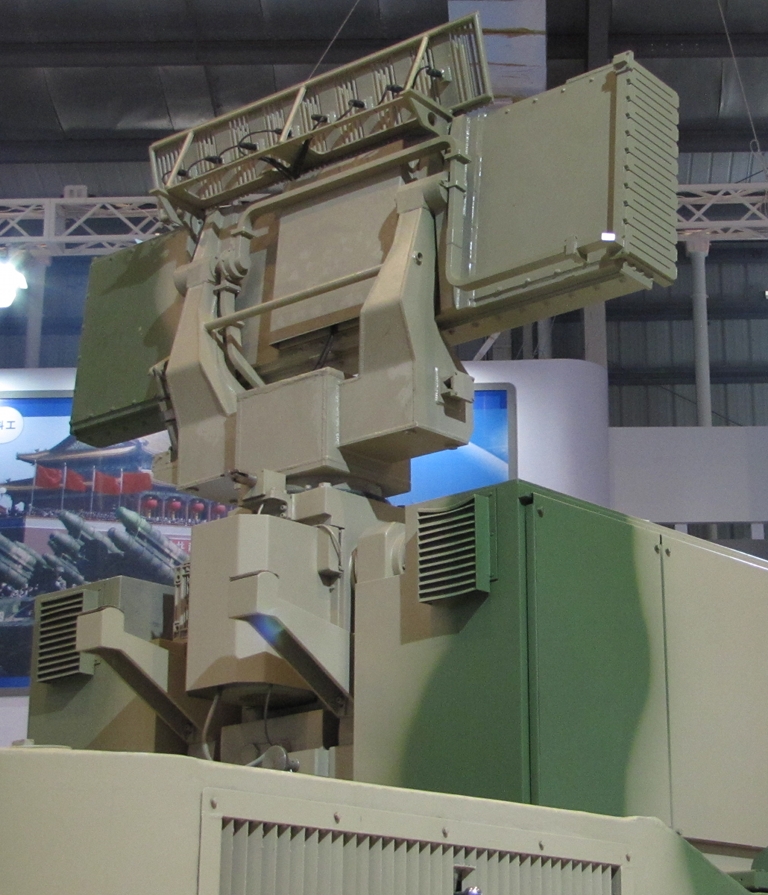
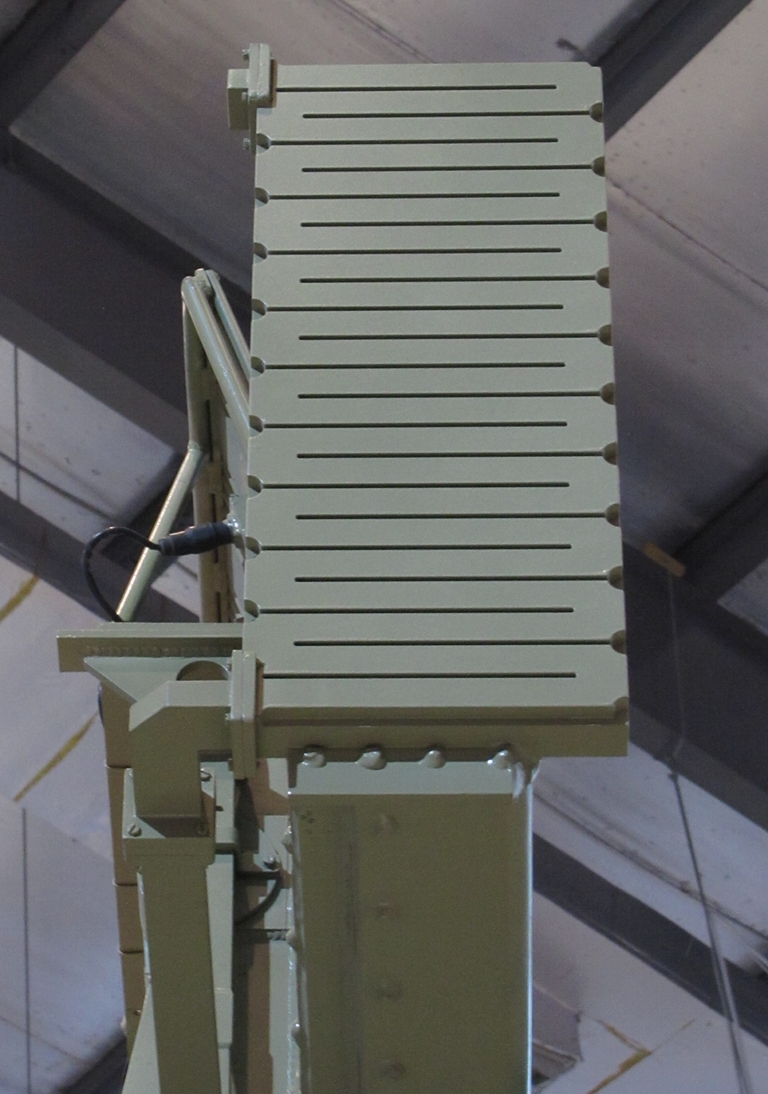
The new FM-90 acquisition radar is a major departure from the Mirador IV and likely has its origins in the family of S-band and L-band planar array acquisition radars developed by CETC. The design is a mechanically rotated planar array with electronic mainlobe steering in elevation, very similar in concept to the new Russian Kupol 9K332 Tor M2/M2E / SA-15D Gauntlet acquisition radar. The FM-90 radar has eleven rows of elements, in 26 columns. This would permit better sidelobe performance than the legacy reflector antenna, but will yield inferior heightfinding accuracy compared to the Tor M2/M2E / SA-15D design. Neither the FM-90 nor the Tor M2/M2E / SA-15D antenna designs are optimal for the crucial “Counter-PGM” role, which requires the ability to accurately track multiple incoming targets in a fixed angular sector, with exceptional heightfinding accuracy to intercept weapons flying steep dive trajectories.
This indicates that the primary role of the FM-90 remains in the engagement of fast jet and low flying helicopter targets. The introduction of a mechanically steered AESA design with a square or near square aspect ratio would be an unambiguous indicator of a role change in the HQ-7 system.
The baseline HQ-9 / FM-80 is hosted on what appears to be an exact clone of the Hotchkiss P4R armoured TELAR / ACU vehicle. This design is, as discussed previously, unconventional. A diesel or gasoline engine is employed to drive an alternator, which in turn drives via a rectifier power supply DC electrical motors on each wheel, the latter coupling torque via a planetary gearing system on each wheel. Messier developed the hydro-pneumatic suspension system. The hydraulic system also powers the three stabilising jacks. The P4R has a road range of 600 km and 60 km/hr road speed to match armoured formations. It can be airlifted by C.160 Transall. Reload time for the TELAR is circa 2 minutes with a proficient crew - comparable to the 9K33 Osa/Romb / SA-8 Gecko.
The new FM-90 6 x 6 vehicle has yet to be publicly designated, or detailed.
HQ-7/FM-80/FM-90 / CSA-4 Sino-Crotale Missile Design
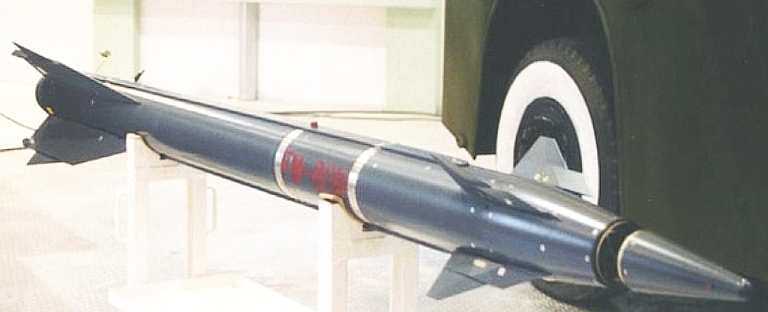
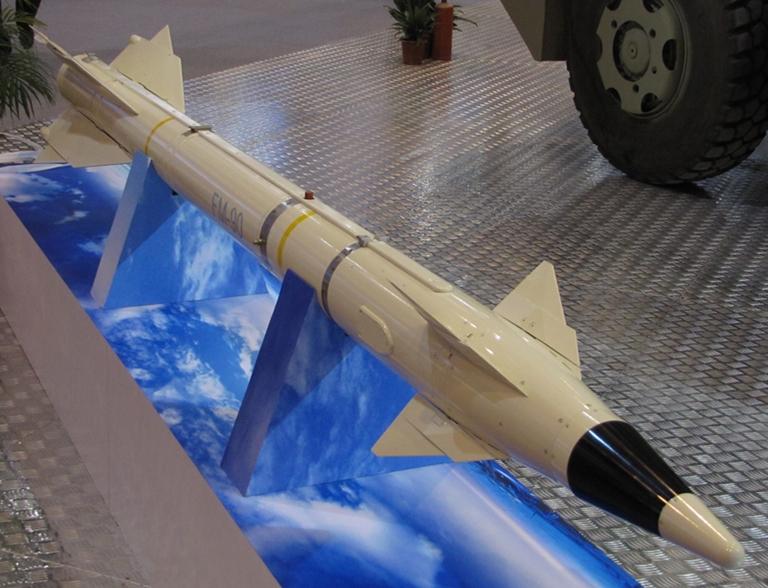
Above, below: HQ-7B/FM-90 Sino-Crotale round on display (image Zhenguan Studio © 2010, Air Power Australia).
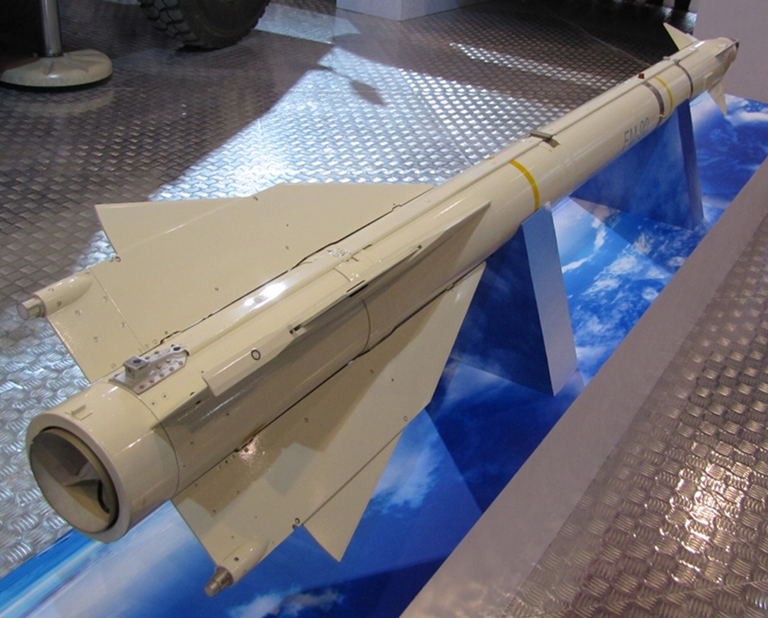

The R440 nose section is fitted with either an infrared proximity fuse, or a Thomson-CSF FPE pulse-Doppler X-band radar proximity fuze standard in naval variants, with both equipped with a backup impact fuse. The proximity fuses are typically armed 350 m prior to estimated impact. The nose canard controls are driven in the pitch/yaw axes by an actuator package in the nose. The nose section includes the battery, power supply and autopilot module.
The centre fuselage carries the 15 kg directional fragmentation warhead which has a lethal radius of 8 metres, producing fragments with a velocity of 2,300 metres/sec. The warhead arms 2.2 sec after launch.
The aft centre fuselage houses the SNPE Lens III solid rocket motor with ~25 kg of propellant, the motor exhausts through a cylindrical exhaust duct to the tail nozzle. The motor impulse is sufficient to accelerate the round to 750 metres/sec in 2.3 seconds.
The tail section contains the roll control actuator, the Ku-band transponder beacon and antenna, the uplink receiver and antenna, and launch tube umbilical interface. Cited transponder types are the Thomson-CSF Stresa with 8 km range in early missiles, and the solid state Thomson-CSF RTKu M with 10+ km range in later missile builds.
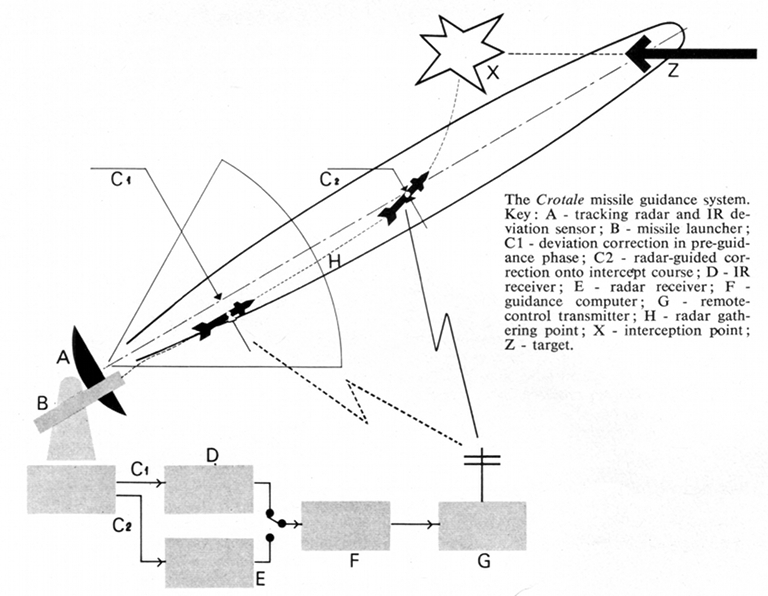
| Crotale R440
Kinematic Performance |
||||
| Range
[km] |
5.0 |
6.0 |
10.0 |
13.0 |
| Flight
Duration
[sec] |
10.0 |
13.0 |
28.0 |
46.0 |
| Load
Factor
[G] |
27.0 |
18.0 |
8.0 |
3.0 |
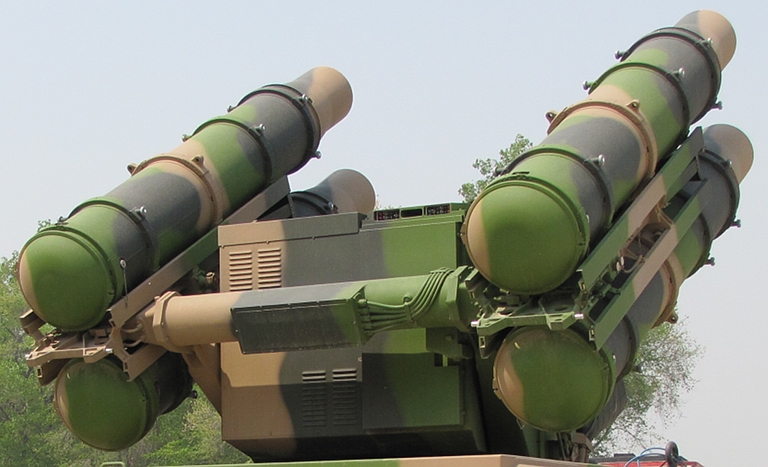
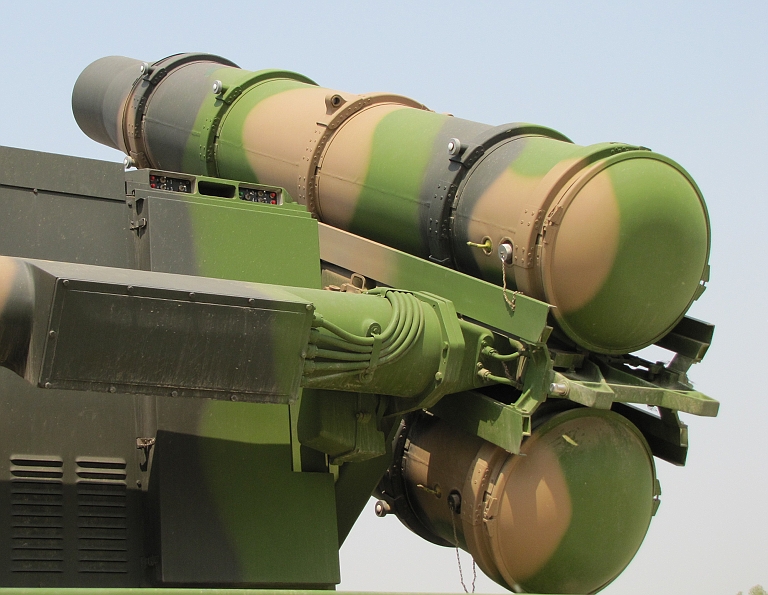
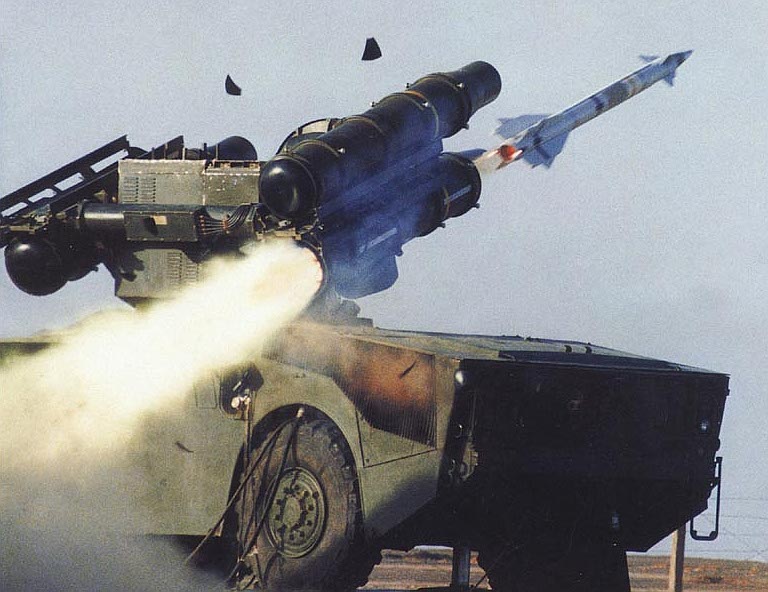
Above, launch from P4R TELAR; below: launch from FM-90 TELAR (via Chinese Internet).
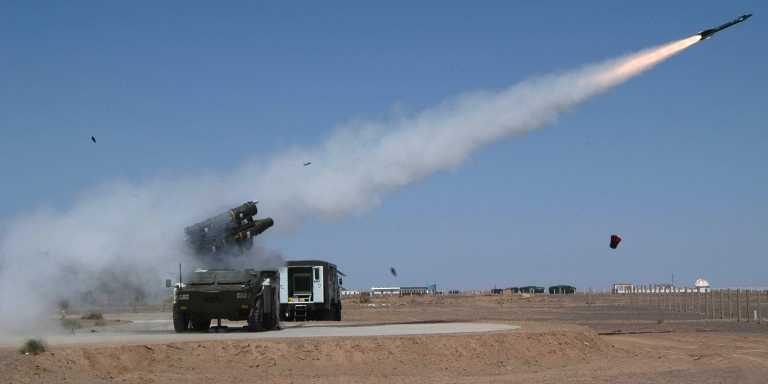
Production and Exports
There is some evidence that the FM-80 was exported to Iran, but numbers have never been disclosed.
HQ-7/FM-80/FM-90 / CSA-4 Sino-Crotale Technical Data
| HQ-7 [Thomson CSF R440 Crotale] Specifications | |
|---|---|
| Length | 2.89 m |
| Diameter | 0.15 m |
| Wing span | 0.54 m |
| Launch weight | 84 kg |
| Propulsion | solid propellant rocket motor |
| Guidance | command link |
| Warhead | 15 kg HE fragmentation with contact and proximity fuzing |
| Max speed | 750 m/s |
| Maximum range | >10 km |
| Minimum
range |
500 m |
| Max effective altitude | 5,000-5,500 m (depending upon target velocity) |
| Min effective altitude | 15 m |
| Reaction time, sec | 6.5 |
| Reload time | 2 min (full 4-round load) |
| Single-Shot
Pk |
0.8 |
| Engagement Radar | Thomson-CSF Ku-band monopulse radar |
| Detection
range |
18.5 km |
| FM-90 Specifications (CNPMIEC) |
|
| Effective
Range |
|
| ASM
Target
600
m/s |
700
-
7,000
m |
| Cruise
Missile
Target
300
m/s |
700
-
11,000
m |
| Aircraft
Target |
700
-
12,000
m |
| Helicopter
Target |
700
-
15,000
m |
| Effective
Altitude |
|
| ASM Target 600 m/s | 30
-
3,000
m |
| Cruise Missile Target 300 m/s | 30
-
6,000
m |
| Aircraft/Helicopter
Target |
30 - 6,000 m |
| Single
Shot
Pk |
≤0.85 |
| Radar
System |
|
| Maximum
Detection
Range
RCS=0.1
m2 |
20
km |
| Maximum Tracking Range RCS=0.1 m2 | 18
km |
| Concurrent
Target
Detection
Qty |
48 |
| Concurrent Target Tracking Qty | 24 |
| Fire
Control
Channels |
7 |
| Reaction
Time |
6.5
to
10.5
sec |
| Missile
Maximum
Velocity |
930
m/s |
| Missile
Maximum
load
Factor |
35
G |
HQ-7/FM-80/FM-90 / CSA-4 Sino-Crotale Battery Components
| HQ-7/FM-80
Battery
Components |
||
| System |
Function/Composition |
Vehicle |
| TELAR
(2-3) |
Self Propelled Transporter Erector Launcher | P4R |
| ACU |
Self
Propelled Engagement Radar |
P4R |
| - |
Transporter
/
Transloader
/
Crane |
- |
HQ-7B/FM-90 Sino-Crotale TELAR
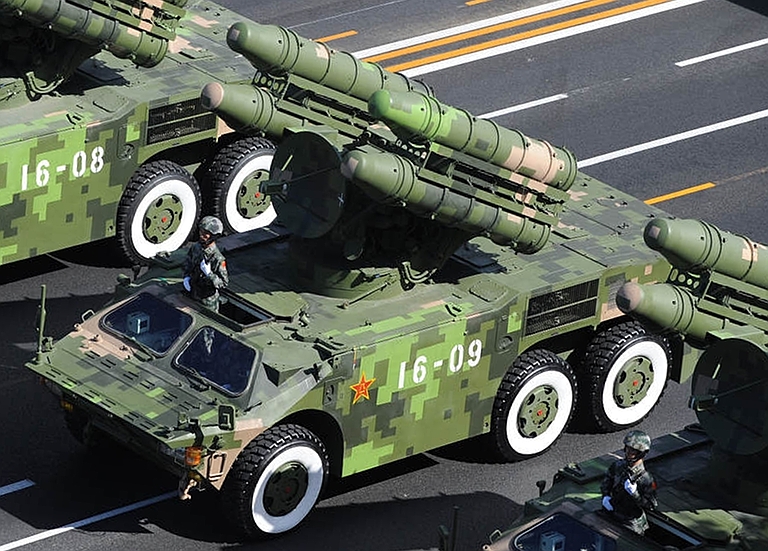
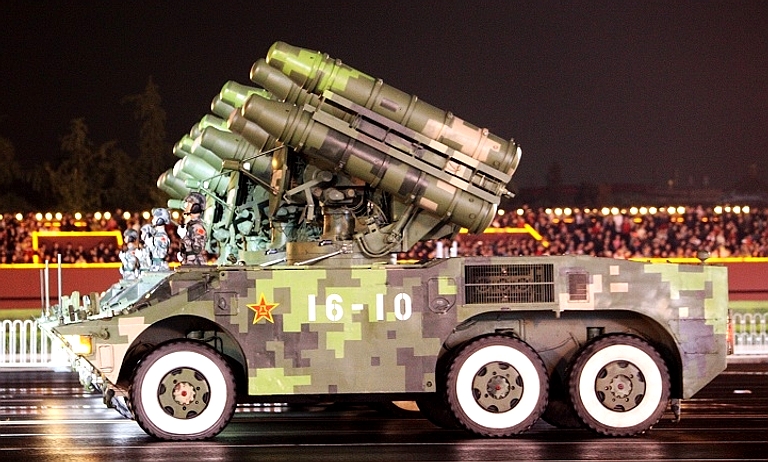
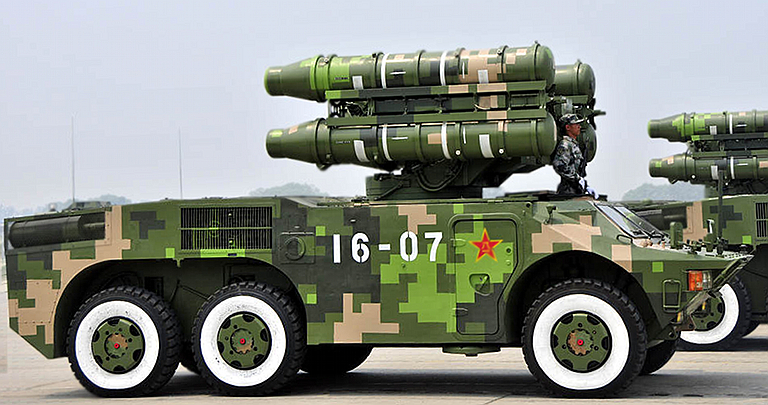
HQ-7B/FM-90 TELAR on parade in 2009 (via Chinese Internet).
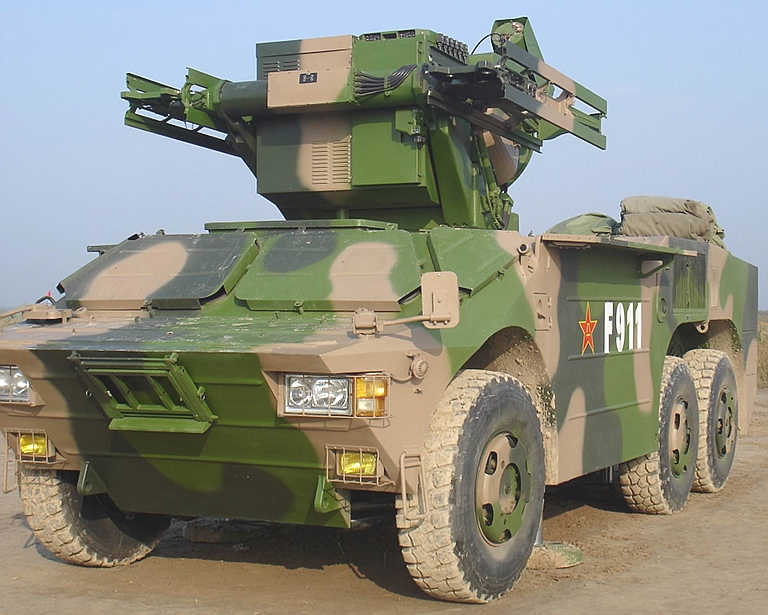
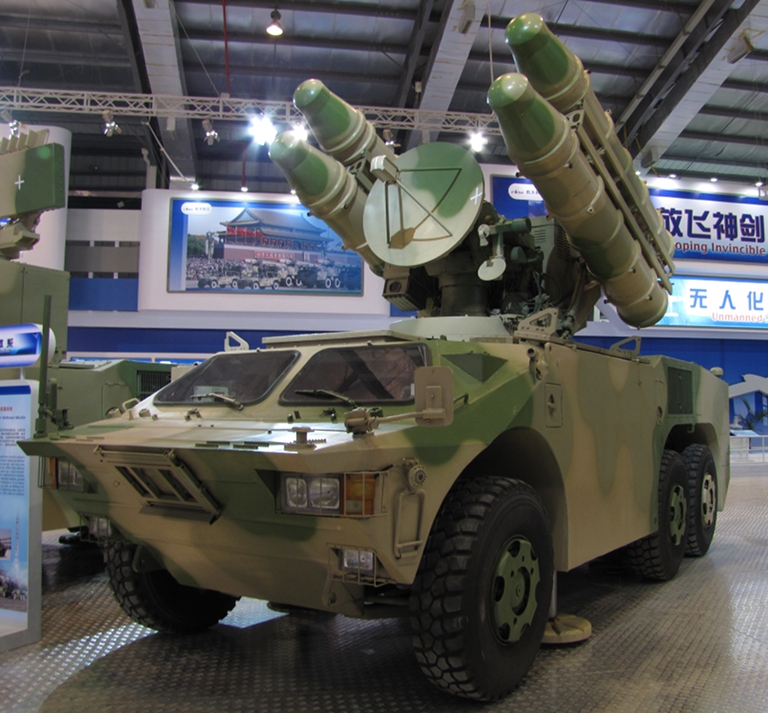
HQ-7B/FM-90 TELAR (image Zhenguan Studio © 2010, Air Power Australia).
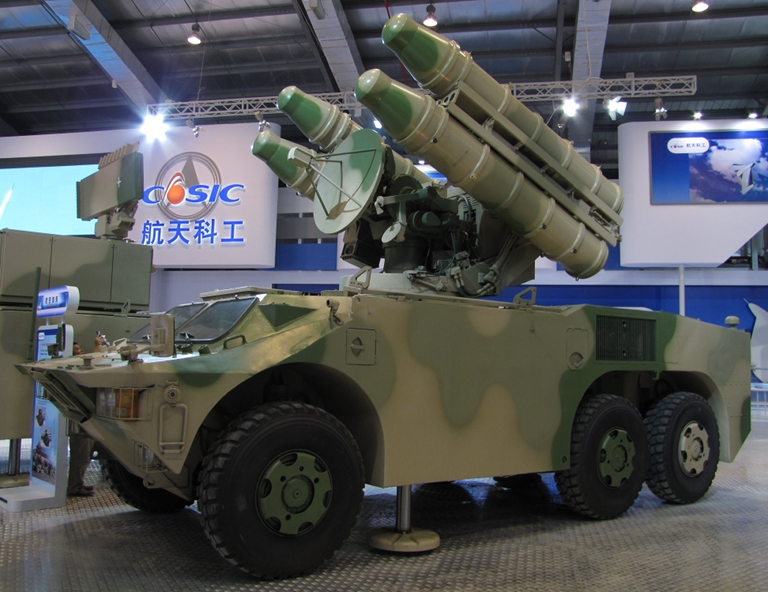
HQ-7B/FM-90 TELAR (image Zhenguan Studio © 2010, Air Power Australia).
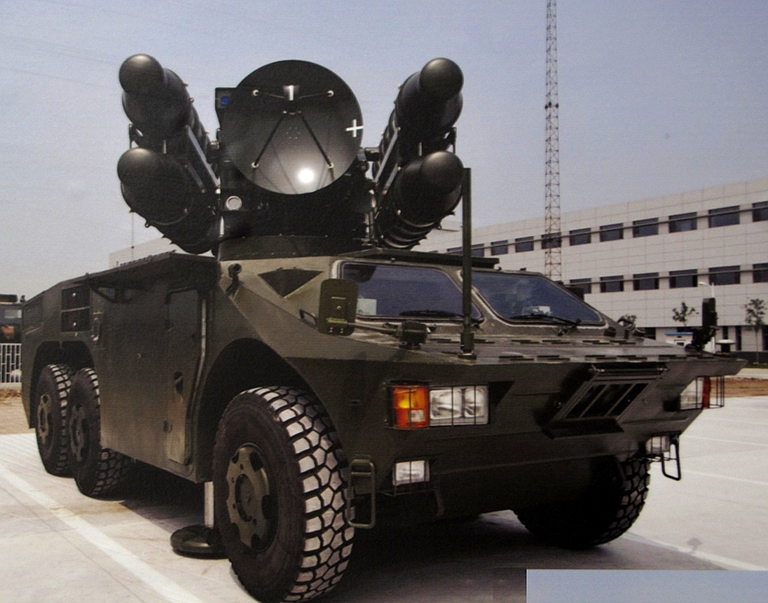
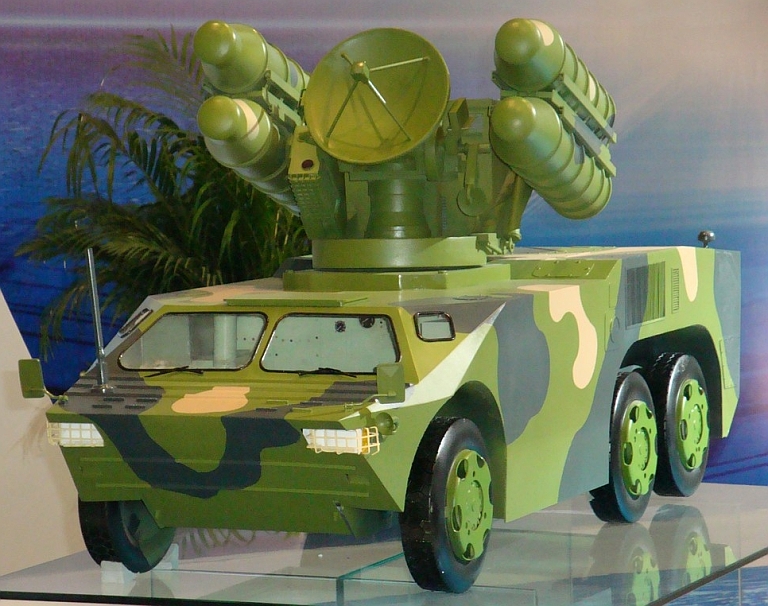
HQ-7/FM-80 Thomson-Hotchkiss P4R Sino-Crotale TELAR
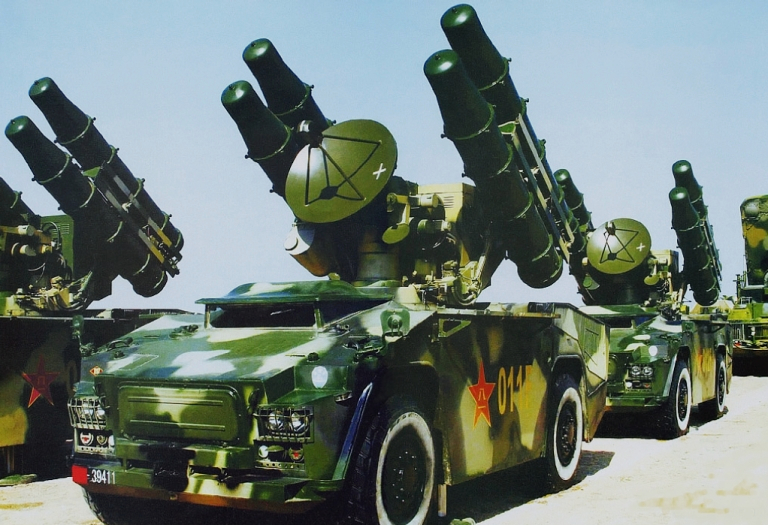
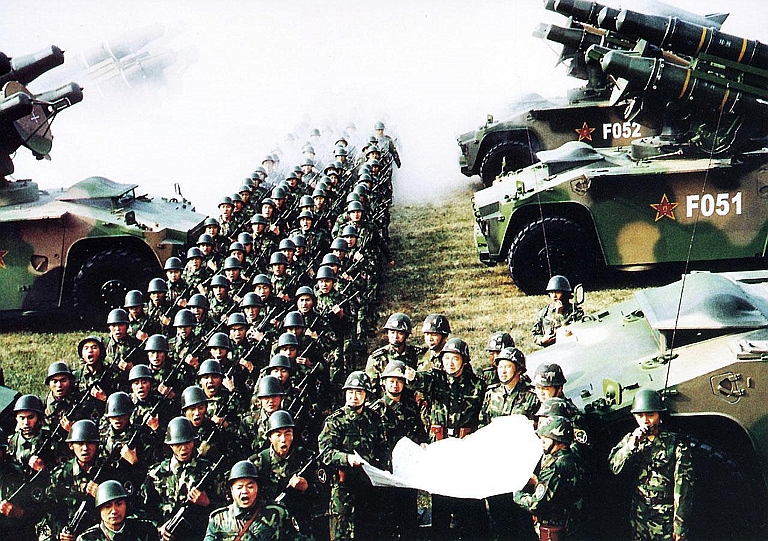
HQ-7 Sino-Crotale Towed TELAR
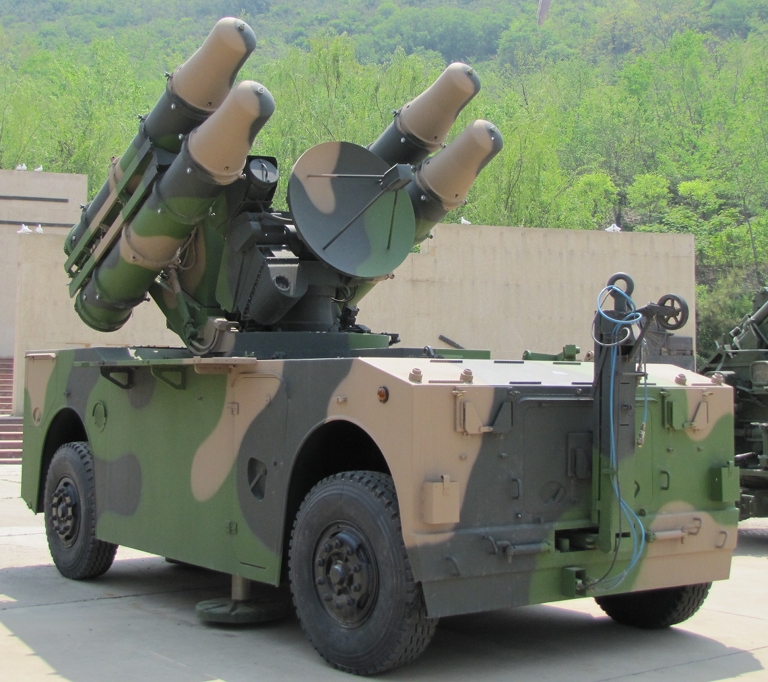
Above, below: Towed HQ-7 TELAR on display at Datangshan (Zhenguan Studio, © 2010 Air Power Australia).
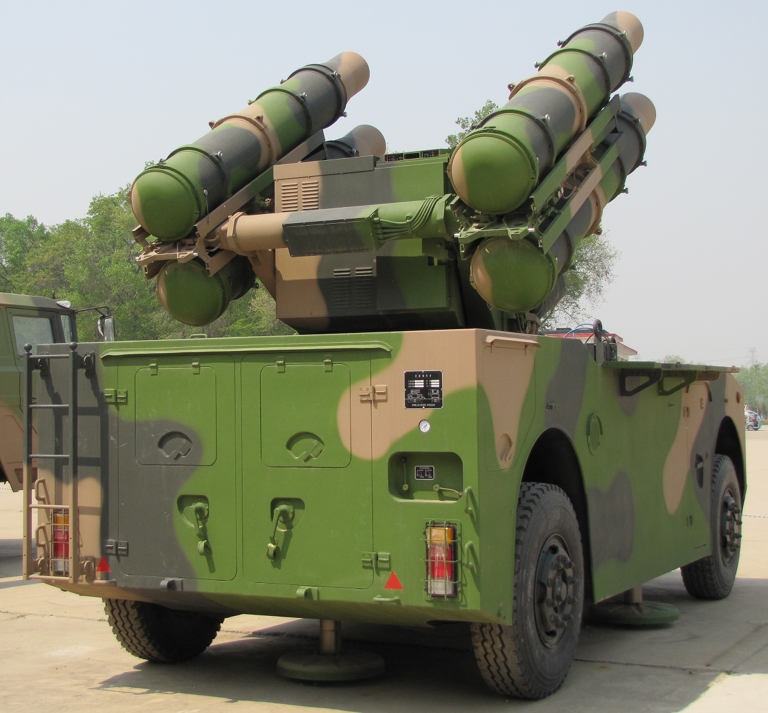
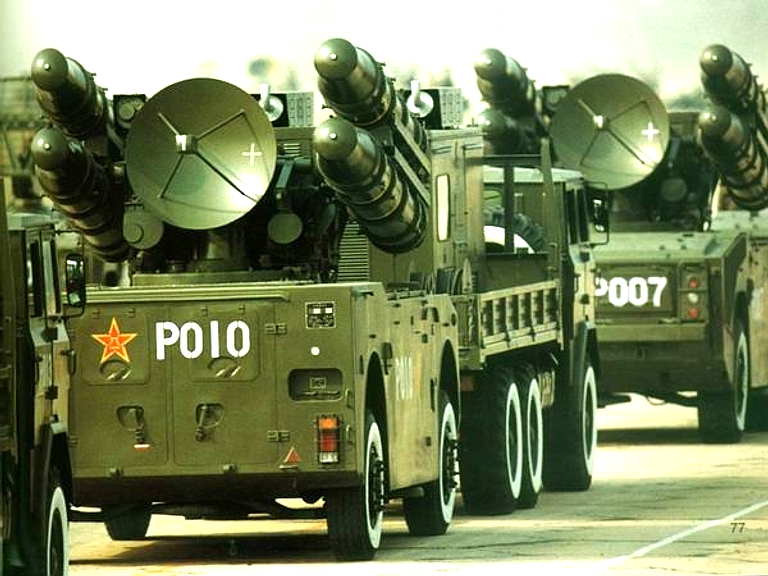
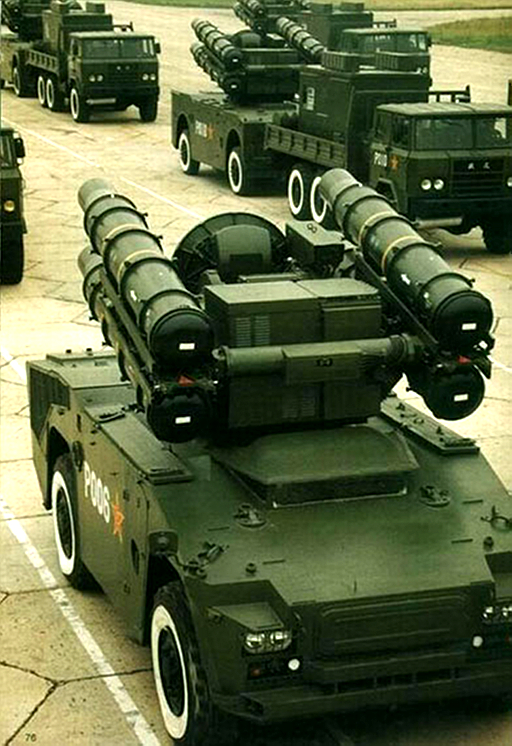
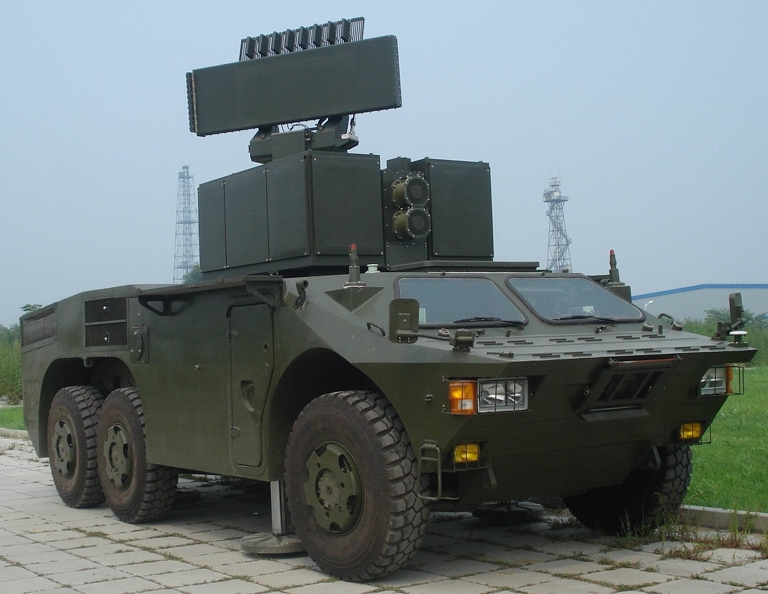
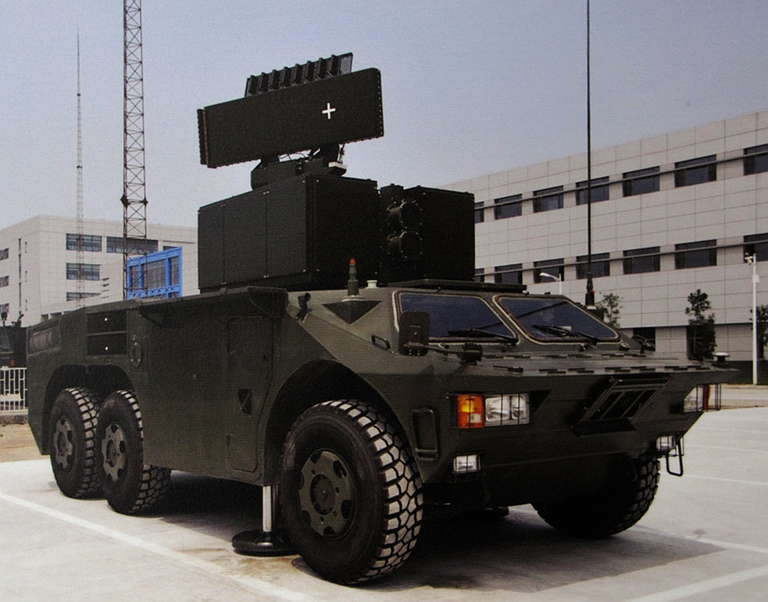
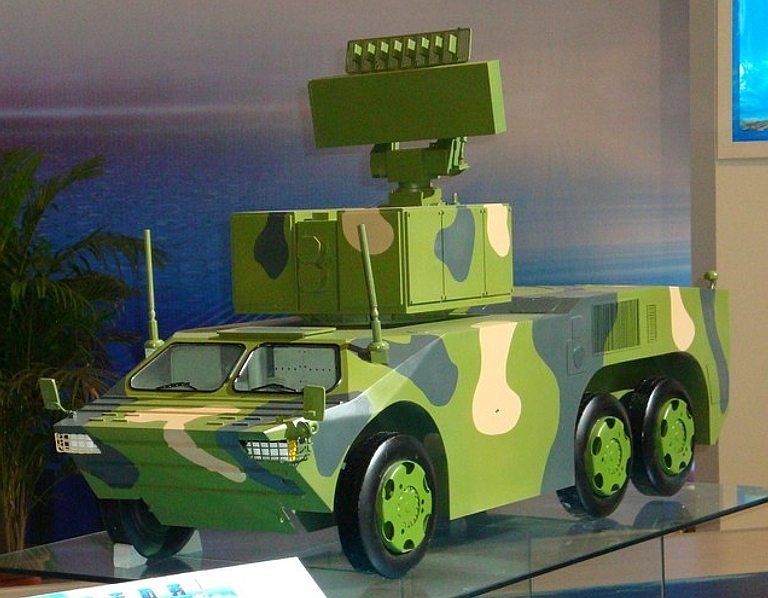
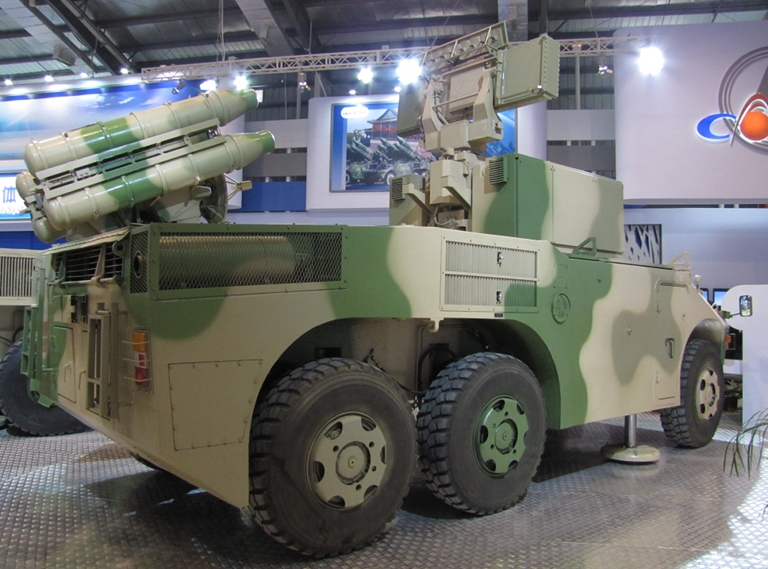
HQ-7/FM-80 Sino-Crotale ACU Self Propelled Acquisition Radar
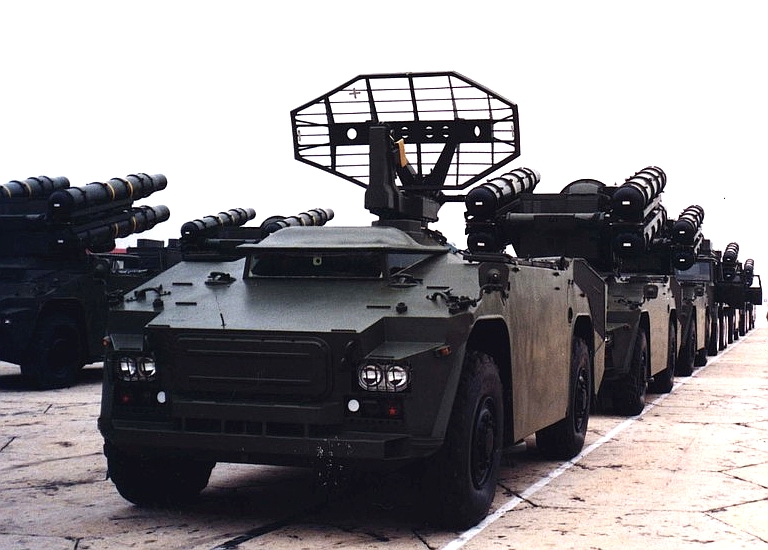
HQ-7/FM-80 acquisition radar deployed on the P4R vehicle (via Chinese Internet).
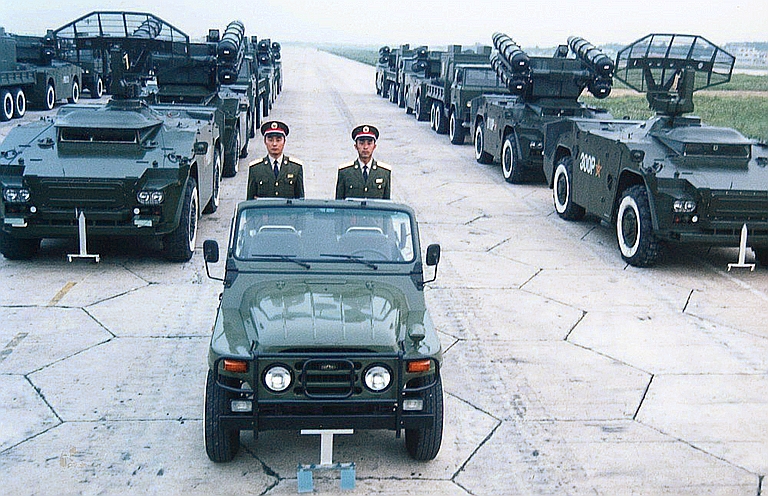
HQ-7/FM-80 acquisition radar deployed on the P4R vehicle (via Chinese Internet).
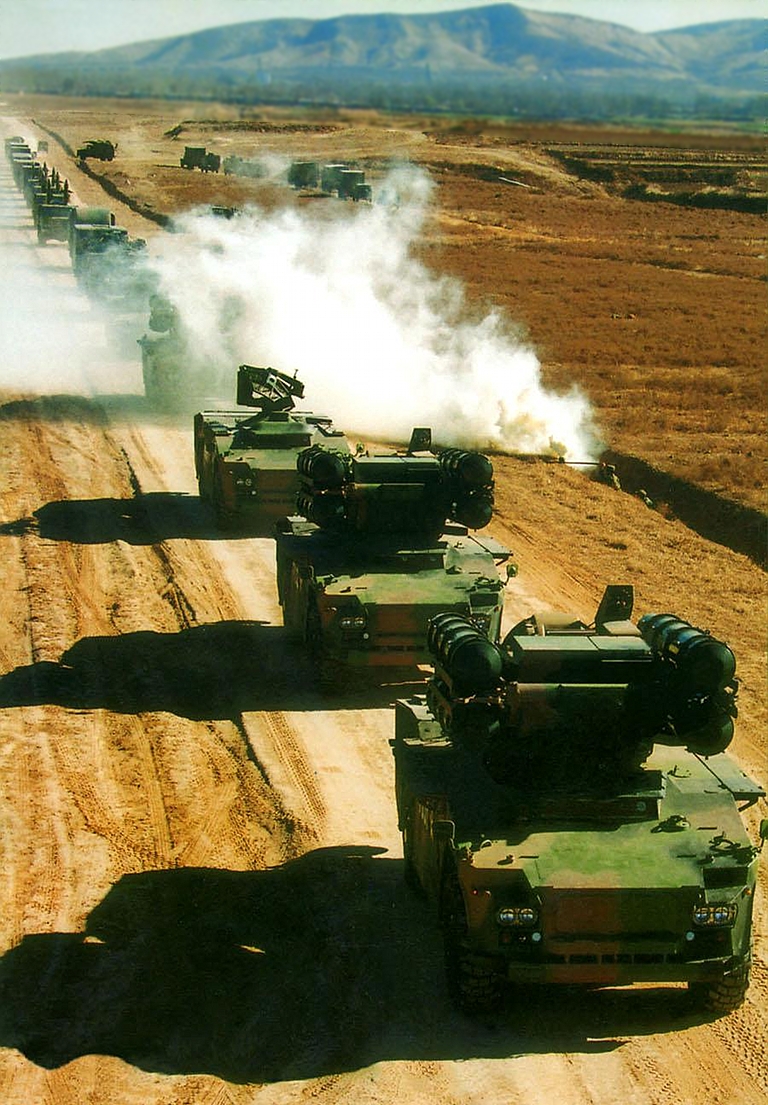
HQ-7/FM-80 acquisition radar stowed on the P4R vehicle (via Chinese Internet).
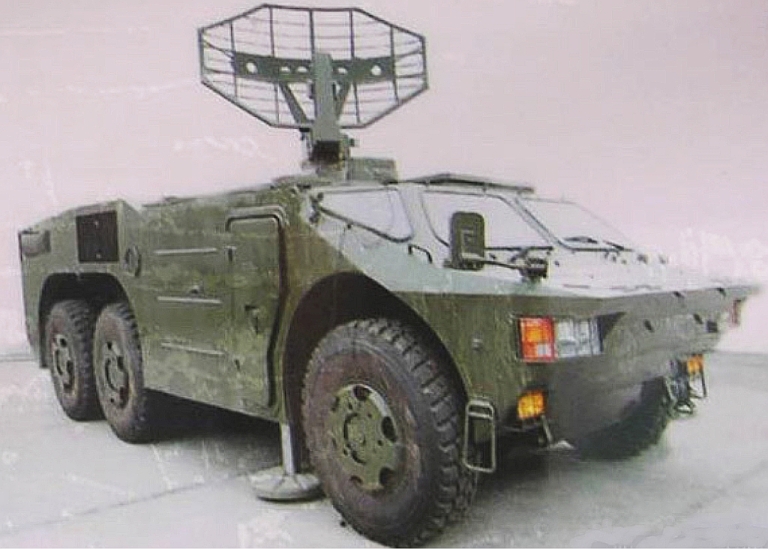
HHQ-7/FM-80(N)/FM-90(N) Naval Sino-Crotale
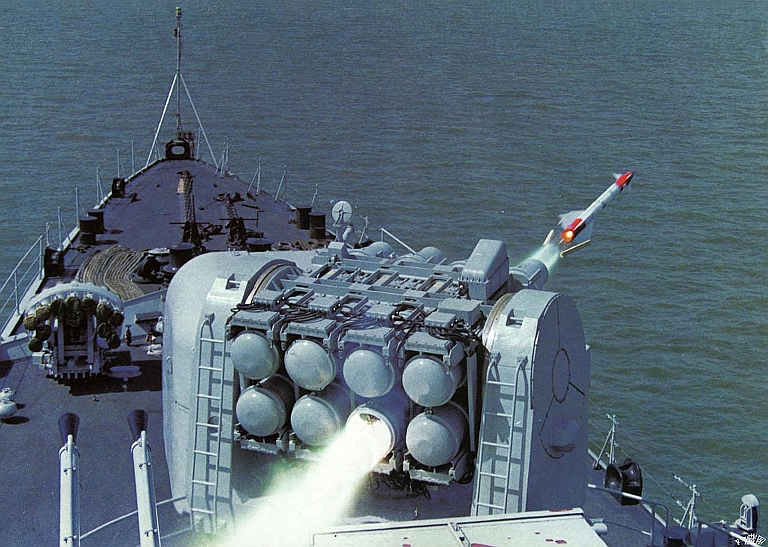
HHQ-7 launch (via Chinese Internet).
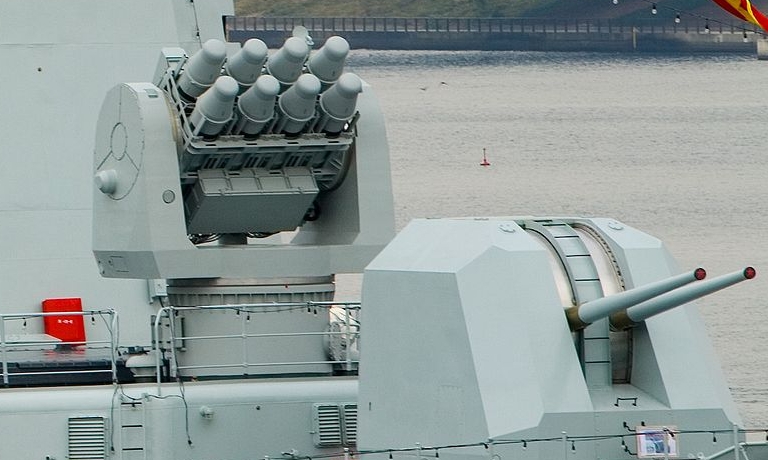
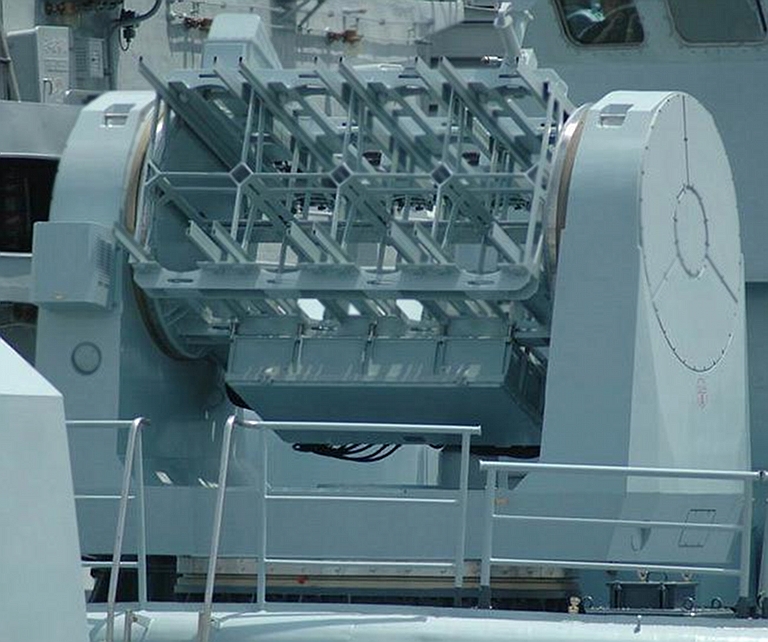
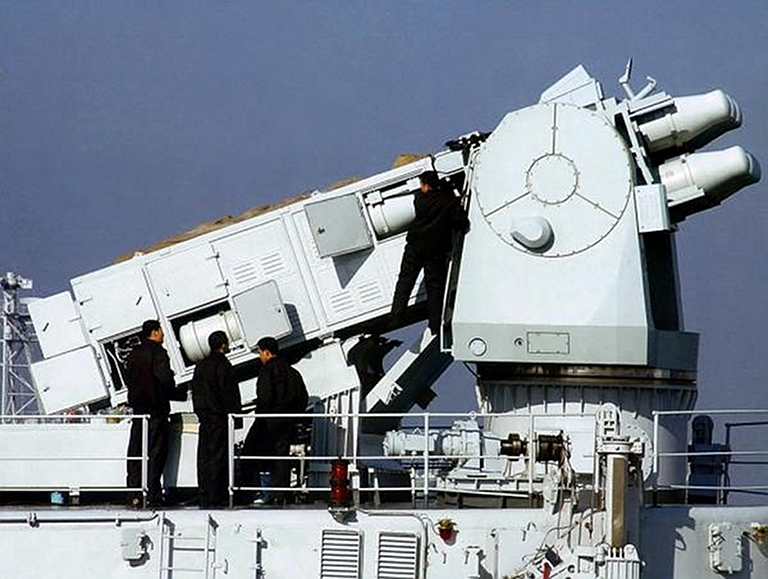
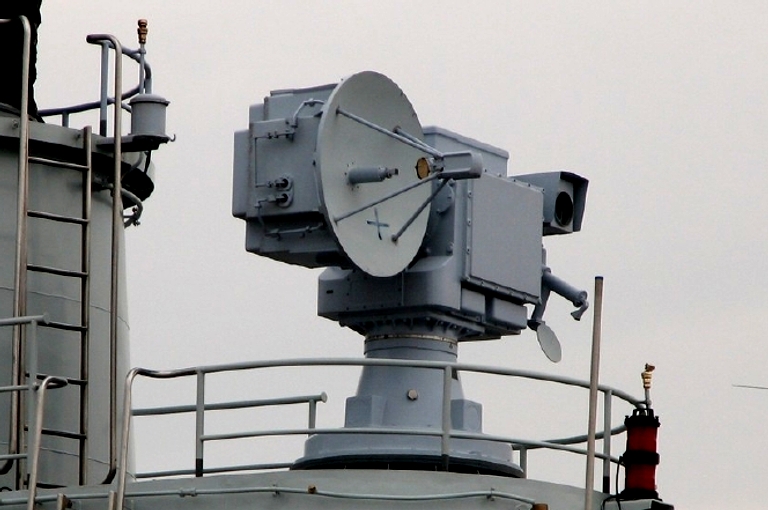
Type 345 HHQ-7 Naval Sino-Crotale engagement radar (image © 2009, Zhenguan Studio).
Notes/References
- Crotale: A Missile Defense System against Supersonic Low-Level Air Attack, International Defense Review 1/1970, Interavia S.A.
- H. le Sueur, Design Philosophy of the Crotale AA
System, International Defense Review - Air Defence Systems, Special
Series, 1976, Interavia S.A.
- Crotale in Service: organizational maintenance of a
missile system, International
Defense
Review 2/1973, Interavia S.A.
- Crotale NG Multi-Mission Air Defense Missile System,
France,
army-technology.com, Net Resources International, URI: http://www.army-technology.com/projects/crotale/
- CNPMIEC HQ-7 (FM-80) and FM-90 surface-to-air
missile systems
(China), Land systems - Air defence - Missiles, Janes, URI: http://www.janes.com/.../CNPMIEC-HQ-7-FM-80-and-FM-90-surface-to-air-missile-systems-China.html
- Line artwork and cited text © 1970 - 1976, Interavia
S.A.; reproduced in accordance with 17 U.S.C. §107,
this material is distributed for non-profit research and
educational purposes only.

|
|||||||||||||
![Sukhoi PAK-FA and Flanker Index Page [Click for more ...]](APA/flanker.png) |
![F-35 Joint Strike Fighter Index Page [Click for more ...]](APA/jsf.png) |
![Weapons Technology Index Page [Click for more ...]](APA/weps.png) |
![News and Media Related Material Index Page [Click for more ...]](APA/media.png) |
||||||||||
![Surface to Air Missile Systems / Integrated Air Defence Systems Index Page [Click for more ...]](APA/sams-iads.png) |
![Ballistic Missiles and Missile Defence Page [Click for more ...]](APA/msls-bmd.png) |
![Air Power and National Military Strategy Index Page [Click for more ...]](APA/strategy.png) |
![Military Aviation Historical Topics Index Page [Click for more ...]](APA/history.png)
|
![Information Warfare / Operations and Electronic Warfare Index Page [Click for more ...]](APA/iw.png) |
![Systems and Basic Technology Index Page [Click for more ...]](APA/technology.png) |
![Related Links Index Page [Click for more ...]](APA/links.png) |
|||||||
![Homepage of Australia's First Online Journal Covering Air Power Issues (ISSN 1832-2433) [Click for more ...]](APA/apa-analyses.png) |
|||||||||||||
| Artwork, graphic design, layout and text © 2004 - 2014 Carlo Kopp; Text © 2004 - 2014 Peter Goon; All rights reserved. Recommended browsers. Contact webmaster. Site navigation hints. Current hot topics. | |||||||||||||
|
Site Update
Status:
$Revision: 1.753 $
Site History: Notices
and
Updates / NLA Pandora Archive
|
|||||||||||||
|
|
Tweet | Follow @APA_Updates | |||||||||||
|
|
|||||||||||||
|
|
|||||||||||||
![F-111 Aardvark Index Page [Click for more ...]](APA/f-111.png)
![F/A-18 Hornet and Super Hornet Index Page [Click for more ...]](APA/fa-18a.png)
![Aerial Refuelling and Airlift Capabilities Index Page [Click for more ...]](APA/aar-lift.png)
![Directed Energy Weapons and Electromagnetic Bombs Index Page [Click for more ...]](APA/dew.png)
![Notices and Updates Index Page [Click for more ...]](APA/notices-128.png)
![APA NOTAM and Media Release Index Page [Click for more ...]](APA/notams-128.png)
![APA Research Activities and Policy / Technical Reports Index [Click for more ...]](APA/research-128.png)
![Search Air Power Australia Website [Click for more ...]](APA/search-128.png)
![Briefings and Submissions - Air Power Australia [Click for more ...]](APA/briefs-128.png)
![Air Power Australia Contacts [Click for more ...]](APA/contacts-128.png)
![Funding Air Power Australia [Click for more ...]](APA/funding-258.png)
